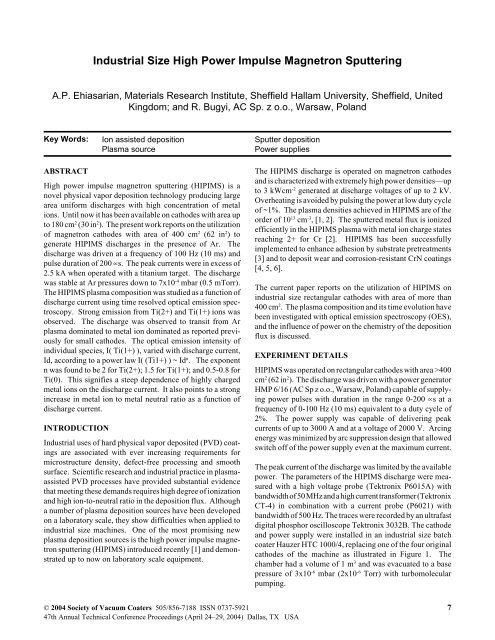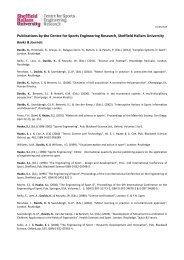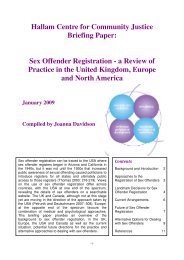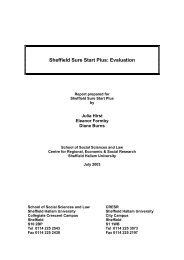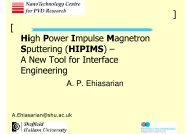Industrial Size High Power Impulse Magnetron Sputtering
Industrial Size High Power Impulse Magnetron Sputtering
Industrial Size High Power Impulse Magnetron Sputtering
You also want an ePaper? Increase the reach of your titles
YUMPU automatically turns print PDFs into web optimized ePapers that Google loves.
Key Words:<br />
<strong>Industrial</strong> <strong>Size</strong> <strong>High</strong> <strong>Power</strong> <strong>Impulse</strong> <strong>Magnetron</strong> <strong>Sputtering</strong><br />
A.P. Ehiasarian, Materials Research Institute, Sheffield Hallam University, Sheffield, United<br />
Kingdom; and R. Bugyi, AC Sp. z o.o., Warsaw, Poland<br />
Ion assisted deposition Sputter deposition<br />
Plasma source <strong>Power</strong> supplies<br />
ABSTRACT<br />
<strong>High</strong> power impulse magnetron sputtering (HIPIMS) is a<br />
novel physical vapor deposition technology producing large<br />
area uniform discharges with high concentration of metal<br />
ions. Until now it has been available on cathodes with area up<br />
to 180 cm2 (30 in2 ). The present work reports on the utilization<br />
of magnetron cathodes with area of 400 cm2 (62 in2 ) to<br />
generate HIPIMS discharges in the presence of Ar. The<br />
discharge was driven at a frequency of 100 Hz (10 ms) and<br />
pulse duration of 200 µs. The peak currents were in excess of<br />
2.5 kA when operated with a titanium target. The discharge<br />
was stable at Ar pressures down to 7x10-4 mbar (0.5 mTorr).<br />
The HIPIMS plasma composition was studied as a function of<br />
discharge current using time resolved optical emission spectroscopy.<br />
Strong emission from Ti(2+) and Ti(1+) ions was<br />
observed. The discharge was observed to transit from Ar<br />
plasma dominated to metal ion dominated as reported previously<br />
for small cathodes. The optical emission intensity of<br />
individual species, I( Ti(1+) ), varied with discharge current,<br />
Id, according to a power law I( (Ti1+) ) ~ Idn . The exponent<br />
n was found to be 2 for Ti(2+); 1.5 for Ti(1+); and 0.5-0.8 for<br />
Ti(0). This signifies a steep dependence of highly charged<br />
metal ions on the discharge current. It also points to a strong<br />
increase in metal ion to metal neutral ratio as a function of<br />
discharge current.<br />
INTRODUCTION<br />
<strong>Industrial</strong> uses of hard physical vapor deposited (PVD) coatings<br />
are associated with ever increasing requirements for<br />
microstructure density, defect-free processing and smooth<br />
surface. Scientific research and industrial practice in plasmaassisted<br />
PVD processes have provided substantial evidence<br />
that meeting these demands requires high degree of ionization<br />
and high ion-to-neutral ratio in the deposition flux. Although<br />
a number of plasma deposition sources have been developed<br />
on a laboratory scale, they show difficulties when applied to<br />
industrial size machines. One of the most promising new<br />
plasma deposition sources is the high power impulse magnetron<br />
sputtering (HIPIMS) introduced recently [1] and demonstrated<br />
up to now on laboratory scale equipment.<br />
The HIPIMS discharge is operated on magnetron cathodes<br />
and is characterized with extremely high power densities—up<br />
to 3 kWcm -2 generated at discharge voltages of up to 2 kV.<br />
Overheating is avoided by pulsing the power at low duty cycle<br />
of ~1%. The plasma densities achieved in HIPIMS are of the<br />
order of 10 13 cm -3 , [1, 2]. The sputtered metal flux is ionized<br />
efficiently in the HIPIMS plasma with metal ion charge states<br />
reaching 2+ for Cr [2]. HIPIMS has been successfully<br />
implemented to enhance adhesion by substrate pretreatments<br />
[3] and to deposit wear and corrosion-resistant CrN coatings<br />
[4, 5, 6].<br />
The current paper reports on the utilization of HIPIMS on<br />
industrial size rectangular cathodes with area of more than<br />
400 cm 2 . The plasma composition and its time evolution have<br />
been investigated with optical emission spectroscopy (OES),<br />
and the influence of power on the chemistry of the deposition<br />
flux is discussed.<br />
EXPERIMENT DETAILS<br />
HIPIMS was operated on rectangular cathodes with area >400<br />
cm2 (62 in2 ). The discharge was driven with a power generator<br />
HMP 6/16 (AC Sp z o.o., Warsaw, Poland) capable of supplying<br />
power pulses with duration in the range 0-200 µs at a<br />
frequency of 0-100 Hz (10 ms) equivalent to a duty cycle of<br />
2%. The power supply was capable of delivering peak<br />
currents of up to 3000 A and at a voltage of 2000 V. Arcing<br />
energy was minimized by arc suppression design that allowed<br />
switch off of the power supply even at the maximum current.<br />
The peak current of the discharge was limited by the available<br />
power. The parameters of the HIPIMS discharge were measured<br />
with a high voltage probe (Tektronix P6015A) with<br />
bandwidth of 50 MHz and a high current transformer (Tektronix<br />
CT-4) in combination with a current probe (P6021) with<br />
bandwidth of 500 Hz. The traces were recorded by an ultrafast<br />
digital phosphor oscilloscope Tektronix 3032B. The cathode<br />
and power supply were installed in an industrial size batch<br />
coater Hauzer HTC 1000/4, replacing one of the four original<br />
cathodes of the machine as illustrated in Figure 1. The<br />
chamber had a volume of 1 m 3 and was evacuated to a base<br />
pressure of 3x10 -6 mbar (2x10 -6 Torr) with turbomolecular<br />
pumping.<br />
© 2004 Society of Vacuum Coaters 505/856-7188 ISSN 0737-5921 7<br />
47th Annual Technical Conference Proceedings (April 24–29, 2004) Dallas, TX USA
Figure 1: Schematic cross section of Hauzer HTC 1000/4<br />
coater with HIPIMS cathode and optical probe. Not to scale.<br />
HIPIMS of Ti was performed in Ar atmosphere at a pressure<br />
of 1x10 -3 mbar (0.75 mTorr). The optical emission from the<br />
dense plasma region of the cathode was collected in situ by a<br />
quartz fibre bundle with collimator positioned in the center of<br />
the chamber (Figure 1). This optical probe was arranged to<br />
view the racetrack of magnetron target surface along its<br />
normal. The light was analyzed with a Jobin Yvon Triax 320<br />
spectrometer (Czerny-Turner geometry) with resolution of<br />
0.12 nm. A photomultiplier tube (Hamamatsu R955) was<br />
used as detector. The entire system was sensitive to the<br />
spectral range 200-950 nm.<br />
The chemistry of the HIPIMS plasma was obtained from OES<br />
measurements averaging over 50 pulses. Time resolved<br />
measurements of the plasma composition were obtained by<br />
monitoring the light signal from a single emission line by<br />
measuring the voltage across the 100 kOhm terminated PMT<br />
output. 16 averages were taken in order to improve the signalto-noise<br />
ratio.<br />
The electron temperature was estimated qualitatively by taking<br />
the ratio of two optical emission lines of Ti (0), namely<br />
363.39 nm with excitation energy of 3.41 eV and the line at<br />
521.04 nm with excitation energy of 2.43 eV. Assuming a<br />
constant species density ratio, a Corona discharge and a<br />
Maxwellian electron energy distribution, the ratio of emission<br />
lines is a direct measure of the electron temperature (Te) in the<br />
plasma [7]. The sensitivity of this method, however, is<br />
confined to a particular range of Te, which in turn is determined<br />
by the difference in excitation energies in the two<br />
8<br />
species. For the particular lines quoted above, the sensitivity<br />
range is for Te < 5 eV. For higher Te > 5 eV, the line ratio is<br />
constant within +/-10 %. These particular lines were chosen<br />
because of the high intensity and because they belong to the<br />
same species and therefore have a constant ratio of density of<br />
species. Plots of discharge current vs. optical emission<br />
intensity were obtained from the peak values obtained in timeresolved<br />
measurements of the current and OES signal respectively.<br />
RESULTS AND DISCUSSION<br />
Plasma Composition<br />
Optical emission spectra of the HIPIMS discharge operated at<br />
a pressure of 1x10-3 mbar on an industrial size rectangular<br />
cathode of area 400 cm2 are displayed in Figure 2.<br />
Figure 2: Optical emission spectrum from HIPIMS on an<br />
industrial size cathode.<br />
Overall, the spectrum contains high intensities of Ti metal<br />
ions. Strong emission from Ti(2+) ions is detected in the<br />
wavelength region 241-256 nm. Dominating the spectrum is<br />
the Ti(1+) emission at 368 and 375 nm. Bands of Ti neutral<br />
lines are visible centered around 363 nm and 374 nm. The<br />
intensities of the ions 2+ and 1+ are extremely high relative to<br />
the intensity of neutral lines. In conventional unbalanced<br />
magnetron (UBM) sputtering, for example, 2+ emission is<br />
almost never observed while 1+ emission at 368.4 nm and<br />
375.8 nm is significantly lower than the neutral lines in the<br />
same region. These findings confirm previous investigations<br />
[2, 8] on plasma composition of HIPIMS on laboratory size<br />
cathodes with area up to 180 cm 2 .
It is well known that the sputtering process generates mainly<br />
a neutral flux with approximately 0.1% metal ion content [9].<br />
Therefore, any metal ionization is due to collisions of the<br />
sputtered atoms with electrons in the dense plasma region.<br />
The probability of ionization depends on the temperature and<br />
density of the plasma electrons.<br />
It is well documented that the energy of electrons is sufficient<br />
to ionize that Ar with ionization potential IP = 15.6 eV even<br />
in conventional UBM plasmas. Thus electrons in HIPIMS<br />
would have sufficient energy to also doubly-ionize Ti with<br />
IP = 13.637 eV. Furthermore, HIPIMS plasma electrons may<br />
have a greater electron temperature because the potentialcarrying<br />
sheath and presheath regions may be extended by the<br />
high discharge voltage conditions.<br />
Figure 3: Time evolution of the plasma at high discharge<br />
current density.<br />
The density of electrons in the HIPIMS plasma is extremely<br />
high, reaching 10 13 cm -3 [2, 9]. This value represents a two<br />
orders of magnitude increase in plasma density over conventional<br />
UBM discharge plasmas. This is expected to promote<br />
high frequency of ionizing collisions between sputtered atoms<br />
and electrons in dense plasma region.<br />
Time Evolution of the Discharge<br />
The time evolution of the HIPIMS plasma on an industrial size<br />
rectangular magnetron is shown in Figure 3. The discharge<br />
current trace is compared to the traces obtained from OES<br />
measurements. It can be seen that simultaneously with the<br />
initiation of the discharge current at 40 µs, the Ar(0) neutral<br />
emission is developed. The Ar(0) signal reaches a local<br />
maximum by 50 µs, some 10 µs after initiation, and then<br />
continues to rise slowly to its absolute maximum at 200 µs.<br />
The Ti(0) emission is detected with a small delay of ~10 µs<br />
relative to the Ar(0) emission. The Ti(1+) and Ti(2+) emission<br />
are initiated one after another with similar delays of ~10<br />
µs. The Ti(0) and Ti(1+) emission peaks at ~160 µs, while the<br />
Ti(2+) emission peaks at ~200 µs. It is interesting to note that<br />
the rate of increase in Ti(2+) emission is significantly slower<br />
than the rest of the species. A similar increase (not shown) has<br />
been observed for a number of other Ti(2+) lines (see Table 1<br />
for a list of observed lines).<br />
Figure 4: Ratio of Ti(0) emission lines and temporal evolution<br />
of the Ti(0) 363.39 nm line.<br />
The overall behavior of the plasma can be separated in two<br />
halves. From 20-50 µs the discharge is comprised almost<br />
entirely of Ar. As the discharge current rises further, a<br />
significant influx of metal atoms and ions in the plasma is<br />
observed. It can be speculated that sputtering is initiated by Ar<br />
bombardment but is then superceded by self-sputtering.<br />
9
Figure 5: Optical emission from Ti(0), Ti(1+), and Ti(2+)<br />
species as a function of HIPIMS discharge current.<br />
Electron Temperature<br />
The temporal evolution of two emission lines of Ti (0) at<br />
363.39 nm and 521.04 nm was measured and the ratio between<br />
them was calculated in an attempt to estimate changes in the<br />
electron temperature during the pulse. Figure 4 shows the<br />
temporal evolution of the Ti (0) 363 nm line and the ratio<br />
calculated from the two lines. The initiation of the discharge<br />
is marked by the detection of emission from the Ti (0) 363.39<br />
nm line at 20 µs. The electron temperature is seen to increase<br />
significantly to approximately 70% of the maximum within<br />
the first 20 µs (
Equation 1 and the corresponding slopes show that the production<br />
of metal ions—Ti(1+) and, especially, the highly<br />
charged Ti(2+)—is strongly influenced by the discharge current.<br />
At the same time, the relationship for Ti(0) is less strong.<br />
This discussion shows that increasing the power of the HIPIMS<br />
discharge leads not only to an increase in deposition rate, but,<br />
significantly, to an increase in the metal ion-to-neutral ratio in<br />
the deposition flux.<br />
CONCLUSIONS<br />
<strong>High</strong> power impulse magnetron sputtering (HIPIMS) has<br />
been performed successfully in industrial size coaters on<br />
industrial size cathodes with area > 400 cm2 . A dedicated<br />
power supply with peak current capability of 2.5 kA was built<br />
(AC Sp. z o.o., Warsaw, Poland) in order to drive the discharge.<br />
Electronic arc suppression technology ensured the<br />
stable operation of the discharge in deposition runs over<br />
several hours.<br />
The high power supplied to the discharge enabled the generation<br />
of highly dense plasmas containing doubly charged<br />
Ti(2+) metal ions and extremely high metal ion-to-neutral<br />
ratios. Investigations of the time evolution of the discharge<br />
showed that a transition from gas to metal plasma occurred<br />
within the pulse. The electron temperature during the pulse<br />
was found to increase rapidly in the initiation phase of the<br />
discharge and then continue increasing at a slower rate until<br />
the end of the power pulse. The plasma composition was<br />
strongly influenced by the power supplied to the discharge.<br />
Increasing the discharge current gave rise to a rapid increase<br />
in Ti(2+), Ti(1+) metal ion intensity and a slower increase in<br />
Ti(0) emission, thus pushing the metal ion-to-neutral ratio to<br />
high values.<br />
ACKNOWLEDGMENTS<br />
This work was financially supported by the European Union<br />
GROWTH (CRAFT) program, contract No. G5ST-CT-2002-<br />
50355<br />
REFERENCES<br />
1. V. Kouznetsov, K. Macak, J.M. Schneider, U. Helmersson,<br />
and I. Petrov, “A novel pulsed magnetron sputter technique<br />
utilizing very high target power densities,” Surf<br />
Coat Technol, 122(2-3);:290, 1999<br />
2. A.P. Ehiasarian, R. New, W.-D. Münz, L. Hultman,<br />
U. Helmersson, and V. Kouznetsov, “Influence of <strong>High</strong><br />
<strong>Power</strong> Densities on the Composition of Pulsed <strong>Magnetron</strong><br />
Plasmas,” Vacuum, 65, (2002), 147<br />
3. W.-D. Münz, A.P. Ehiasarian, and P.Eh. Hovsepian,<br />
“Kombiniertes Beschichtungs Verfahren, magnetfeldunterstützteHochleistungs-Impuls-Kathodenzerstäubung<br />
und unbalanziertes <strong>Magnetron</strong>,” German, European,<br />
and USA patent application No. 101 24 749.4<br />
4. A.P. Ehiasarian, W.-D. Münz, L. Hultman, U. Helmersson,<br />
and I. Petrov, “<strong>High</strong> <strong>Power</strong> Pulsed <strong>Magnetron</strong> Sputtered<br />
CrNx Films,” Surf. Coat. Technol., 163-164, (2003),<br />
p.267-272<br />
5. A.P. Ehiasarian, P.Eh. Hovsepian, W.-D. Münz,<br />
L. Hultman, and U. Helmersson, “Comparison of microstructure<br />
and mechanical properties of chromium nitridebased<br />
coatings deposited by high power impulse magnetron<br />
sputtering and by the combined steered cathodic arc/<br />
unbalanced magnetron technique,” Thin Solid Films (2003)<br />
in print<br />
6. V. Kouznetsov, U.S. Patent No. 6,296,742 “Method and<br />
Apparatus for Magnetically Enhanced <strong>Sputtering</strong>,” March<br />
1997<br />
7. R. Pintaske, Th. Welzel, M. Schaller, N. Kahl, J. Hahn,<br />
and F. Richter, “Spectroscopic studies of a magnetron<br />
sputtering discharge for boron nitride deposition,” Surf.<br />
Coat. Technol., 99, (1998), 266<br />
8. J. Böhlmark, A.P. Ehiasarian, J. Alami, P.Eh. Hovsepian,<br />
and U. Helmersson, “Optical emission study of the ionization<br />
fractions in a high power pulsed magnetron plasma,”<br />
47th Annual Technical Conference Proceedings of the<br />
Society of Vacuum Coaters, April 24–29, 2004, Dallas,<br />
TX, USA<br />
9. Ed. R. Behrisch and K. Klaus Wittmaack, “<strong>Sputtering</strong> by<br />
particle bombardment,” Berlin, Springer, 1981-91<br />
11


